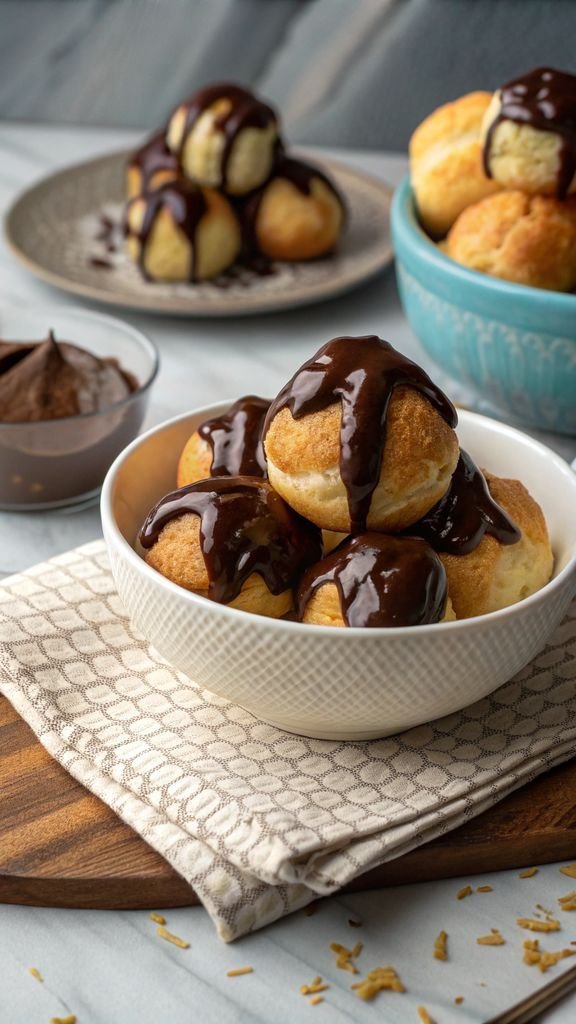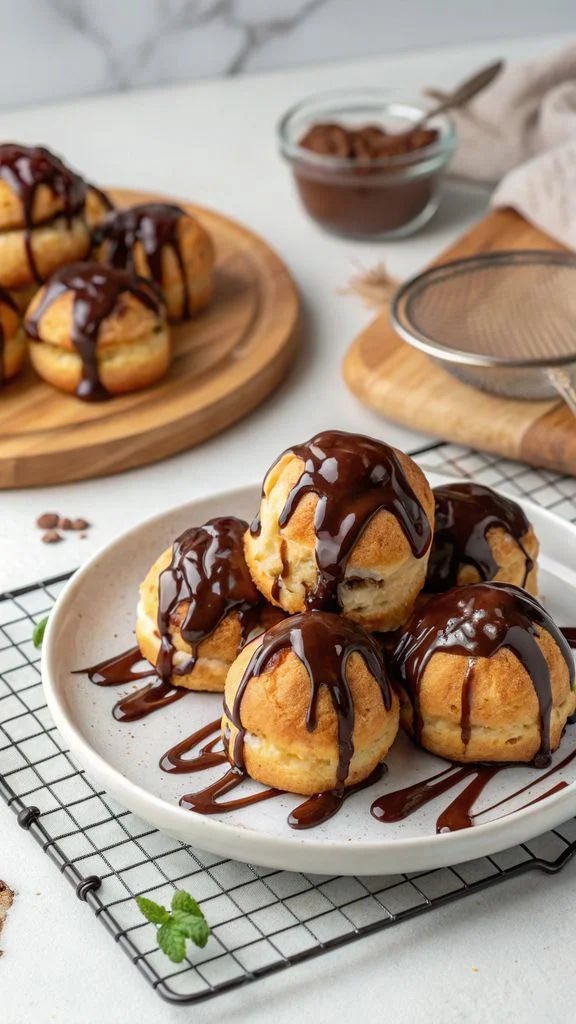The Ultimate Guide to Perfect Profiteroles
There’s something undeniably magical about biting into a profiterole. That crisp, golden shell shatters to reveal a cloud of cool, creamy filling, all draped in glossy chocolate—a textural symphony perfected over centuries. These elegant French pastries, whose name derives from the word “profit” (meaning “small gift”), have graced tables since the 16th century. Legend credits Catherine de Medici’s chef, Popelini, with their creation, but they soared to fame in the 19th century when Parisian pâtissier Antonin Carême refined them into the delicate puffs we adore today. Beyond their Parisian café roots, profiteroles became synonymous with celebration—wedding feasts, holiday gatherings, and milestone dinners. Their universal appeal lies in that irresistible contrast: the humble choux pastry transforms through heat and technique into edible velvet, while the filling (traditionally crème pâtissière or whipped cream) offers lush simplicity. For me, profiteroles evoke memories of my grandmother’s kitchen—her hands deftly piping dollops of dough, the warm scent of baking butter, and the shared joy of assembling towers drenched in chocolate. They’re a dessert that feels simultaneously sophisticated and comforting, and mastering them is a rite of passage for any home baker.

Why You’ll Love This Recipe
You’ll fall head over heels for these profiteroles because:
1. They’re secretly simple—Once you master the choux technique (easier than you think!), you’ll have a versatile base for countless desserts.
2. Texture heaven—Experience the addictive crunch-give-creaminess combo that makes these irresistible.
3. Impress factor—Few desserts look as elegant with minimal effort. Stack them high or plate them artfully for gasps of delight.
4. Make-ahead magic—Every component can be prepared in advance, making them perfect for stress-free entertaining.
Ingredients
Quality matters here! Use European-style butter (82% fat) for optimal rise, and fresh, room-temperature eggs.
For the Choux Pastry:
- 1 cup (240ml) water
- ½ cup (115g) unsalted butter, cubed
- ¼ tsp fine sea salt
- 1 tsp granulated sugar
- 1 cup (120g) bread flour, sifted Twice! (Bread flour’s high protein gives structure)
- 4 large eggs, room temperature
For the Vanilla Pastry Cream:
- 2 cups (480ml) whole milk
- 1 vanilla bean (or 2 tsp pure vanilla extract)
- ½ cup (100g) granulated sugar
- 4 large egg yolks
- 3 tbsp cornstarch
- 2 tbsp unsalted butter
- Pinch of salt
For the Chocolate Sauce:
- 8 oz (225g) bittersweet chocolate (70% cacao), finely chopped
- 1 cup (240ml) heavy cream
- 2 tbsp light corn syrup (optional, for shine)
- Pinch of sea salt
Equipment Needed
- Medium saucepan
- Wooden spoon or stiff spatula
- Stand mixer or electric hand mixer
- Piping bags
- ½-inch round piping tip (e.g., Wilton #12)
- Baking sheets (light-colored, heavy-gauge)
- Parchment paper or silicone mats
- Wire rack
- Whisk
- Instant-read thermometer (optional but helpful)
Step-by-Step Instructions
Making the Choux Pastry:
- Prepare the dough base: Combine water, butter, salt, and sugar in a saucepan. Bring to a full rolling boil over medium heat. Reduce heat to low, add all the flour at once, and stir vigorously with a wooden spoon until a smooth ball forms that pulls away from the pan (about 2 minutes). A thin film should coat the pan bottom—this cooks the flour. Transfer dough to a stand mixer bowl; cool 5 minutes.
- Incorporate eggs: With the mixer on medium-low, add eggs one at a time, beating fully after each. The dough will look curdled initially but will become smooth, glossy, and pipeable. It should form a “V” shape when the beater is lifted. See the image below for the ideal glossy consistency!
- Pipe the puffs: Preheat oven to 425°F (220°C). Line baking sheets with parchment. Fill a piping bag fitted with a ½-inch tip. Pipe 1½-inch mounds, spacing 2 inches apart. Dip a finger in water and gently smooth any peaks (they’ll burn).
- Bake with precision: Bake 15 minutes at 425°F until puffed. Without opening the oven, reduce heat to 350°F (175°C). Bake 20-25 minutes more until deep golden and hollow-sounding when tapped. Turn off the oven; prop the door open with a spoon. Let dry inside for 10 minutes. Transfer to a wire rack.
Making the Pastry Cream:
- Infuse the milk: Heat milk with split vanilla bean seeds (or extract) in a saucepan until steaming. Remove from heat; cover and steep 15 minutes.
- Temper the yolks: Whisk sugar, yolks, cornstarch, and salt until pale. Slowly whisk in ½ cup hot milk. Pour everything back into the saucepan.
- Cook to perfection: Cook over medium heat, whisking constantly, until thick and bubbling (about 3-5 minutes). Boil 1 minute. Off heat, whisk in butter. Strain into a bowl; press plastic wrap onto the surface. Chill 4 hours.
Making the Chocolate Sauce:
- Create the sauce: Heat cream until simmering. Pour over chocolate and corn syrup (if using) in a heatproof bowl. Let sit 2 minutes, then whisk until smooth. Stir in salt.
Assembly:
- Fill the puffs: Once pastry shells are cool, poke a hole in each base with a piping tip. Fill a piping bag fitted with a small tip with pastry cream. Pipe into shells until they feel heavy. The image above shows perfectly filled profiteroles—plump but not bursting!
- Serve with flair: Arrange profiteroles on a platter. Drizzle warm chocolate sauce generously. Dust with powdered sugar or cocoa if desired.
Tips for Perfect Results
- Eggs at room temp: Cold eggs can break the emulsion. Set them out 30 minutes ahead.
- Cook the dough thoroughly: That pan film ensures starch gelatinization, which traps steam for maximum puff.
- No peeking: Resist opening the oven early! Steam escape causes collapse.
- Dry thoroughly: The post-bake oven rest prevents sogginess by evaporating internal moisture.
- Chill cream fully: Warm pastry cream melts the shells.
- Sauce consistency: For a thicker coating, cool sauce slightly before drizzling.
Storage and Make-Ahead Instructions
- Unfilled shells: Store in an airtight container at room temperature for 24 hours or freeze for 1 month. Refresh in a 300°F (150°C) oven for 5 minutes before filling.
- Pastry cream: Refrigerate for 3 days. Whisk until smooth before using.
- Chocolate sauce: Refrigerate for 2 weeks. Reheat gently with a splash of cream.
- Filled profiteroles: Assemble up to 2 hours ahead. Keep refrigerated. Add sauce just before serving to maintain crispness.
Variations and Substitutions
- Filling swaps: Swap pastry cream for stabilized whipped cream (1 cup cream + 2 tbsp powdered sugar + 1 tsp vanilla, whipped to stiff peaks). For a lighter option, use vanilla ice cream.
- Flavored choux: Add 1 tsp orange zest or 2 tbsp cocoa powder to the flour for citrus or chocolate shells.
- Sauce alternatives: Replace chocolate with salted caramel or passionfruit coulis.
- Vegetarian note: The recipe is naturally vegetarian. For vegan, use plant-based butter and milk, and a flax “egg” slurry (mix with caution—results vary).
Maddy’s Tips for Success
Drawing from years of choux trials, here are my non-negotiables:
– Weigh your flour: Volume measurements vary. 120g bread flour is critical.
– Beat the dough until it sighs: After adding eggs, mix until the dough slowly drops from the beater in a thick ribbon.
– Use light pans: Dark sheets over-brown bottoms. If you must use them, double-pan for insulation.
– Piping pressure: Squeeze firmly, then lift straight up without swirling for even rounds.
Frequently Asked Questions
Q: Can I make mini or giant profiteroles?
A: Absolutely! For mini (1-inch), bake 10 minutes at 425°F, then 10-15 minutes at 350°F. For large (3-inch), bake 20 minutes + 25-30 minutes. Adjust filling accordingly.
Q: Why did my puffs collapse?
A: Likely underbaking or oven opening. Ensure they’re deeply golden and sound hollow. Cool them properly in the turned-off oven.
Q: My pastry cream is lumpy! Can I fix it?
A: Yes! Strain it immediately after cooking. If cooled and lumpy, blend briefly with an immersion blender.
Q: Can I use all-purpose flour?
A: Bread flour’s higher protein gives better structure. If substituting AP flour, add 1 tbsp vital wheat gluten per cup or expect slightly less rise.
Q: How do I prevent soggy bottoms?
A: Cool puffs completely before filling. If storing filled profiteroles, place them on a paper towel-lined tray to absorb moisture.
Q: Can I skip the corn syrup in the sauce?
A: Yes, but it adds shine and prevents seizing. For a substitute, use 1 tsp honey or omit entirely.
Nutrition Information
While profiteroles are a treat, they balance indulgence with portion control. Each puff (unfilled) has ~70 calories. The pastry cream provides protein and calcium from eggs and milk, while dark chocolate offers antioxidants. Moderation is key—but life’s too short not to savor a few!
Serving Suggestions
- Classic tower: Stack filled profiteroles into a pyramid. Pour warm chocolate sauce over the top, letting it cascade down the sides.
- Elegant plating: Arrange three profiteroles on a dessert plate. Drizzle with sauce, add fresh berries, and garnish with mint.
- Interactive dessert bar: Set out filled puffs, warm sauce, and toppings (toasted nuts, sprinkles, sea salt) for guests to customize.
There you have it—the secrets to ethereal profiteroles that’ll transport you to a Parisian pâtisserie. Don’t let the French name intimidate you; with patience and passion, you’ll create edible jewels worth celebrating. As the chocolate glaze sets on your masterpiece (just like in the photo above), take a bow—you’ve conquered choux! Now, gather your loved ones, pour the coffee, and relish every blissful bite. Bon appétit! 🥐✨

